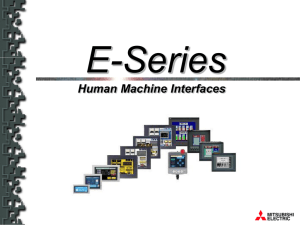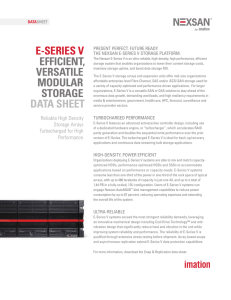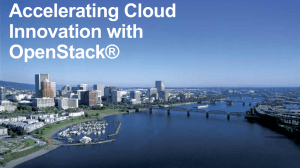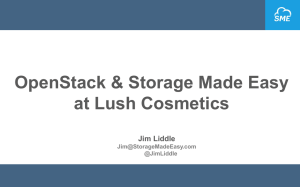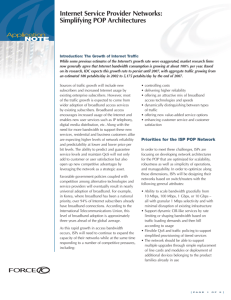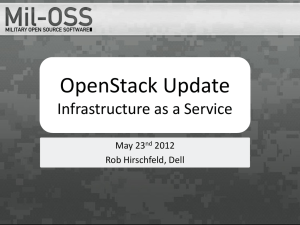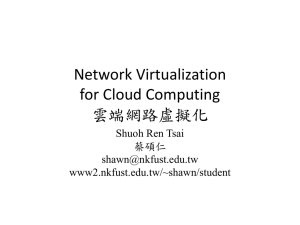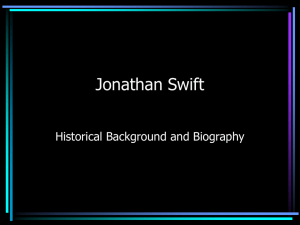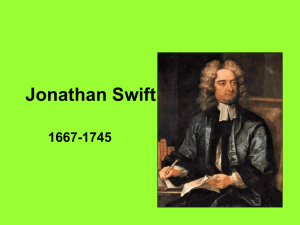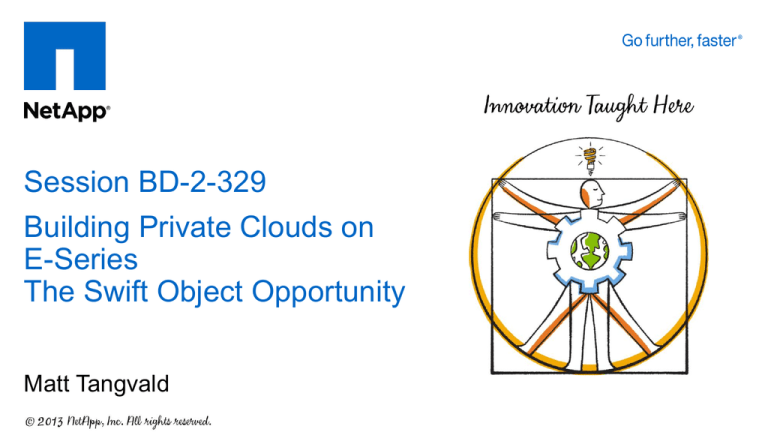
Session BD-2-329
Building Private Clouds on
E-Series
The Swift Object Opportunity
Matt Tangvald
Agenda (60 min.)
NetApp OpenStack Overview
10 min.
E-Series + Swift
30 min.
Call to Action
5 min.
Q&A
15 min.
2
NetApp OpenStack
Overview
3
3 Clusters Private Cloud
Today
Tomorrow
Dedicated Vertical Silos Transform to Dynamic Clusters
4
p, Inc. All rights reserved.
OpenStack: What Is It?
The decoder ring:
Service
OpenStack
Project Name
Amazon
Virtual Machines
Compute
Nova
EC2
Virtual Block Devices
Block Storage
Cinder
EBS
Object Storage
Object Storage
Swift
S3
Virtual Networks
Networking
Neutron (formerly Quantum)
VPC
App Orchestration
Orchestration
Heat
CloudFormation
App Monitoring
Measurement
Ceilometer
CloudWatch
Tenant Auth / Namespace
Identity
Keystone
IAM
Boot Images
Image Service
Glance
AMI
Dashboard
Dashboard
Horizon
Management Console
5
When to Sell...
In the Storage
Where is Data
Management?
Outside the storage
Shared, General
What kind of
workloads?
Application Driven
Entry/Mid-Range & Enterprise
Type of
environment?
Entry/Mid-Range & Performance
Unified
Unified or Block?
Block
Scale Out Scale Up
Scale?
Scale Up
FAS
E-Series
6
OpenStack and NetApp Storage
Scalable Object
Private Cloud
VM Image
App Interface
Servers
Network
Storage
E-Series
Application Driven
Storage Access
FAS
Shared Infrastructure
E-Series and FAS are Complimentary
7
E-Series + Swift
8
Object Storage Performance Continuum
Archival
Mixed Use
Transaction Processing
• ILM
• Tape replacement
• Large file
• Example: StorageGRID
• Capacity driven
• Random I/O
• Multiple workloads
• Large + small file
• Home directory replacement
• Examples:
• OpenStack Swift
• Ceph
• High performance
• Small objects
• Examples
• Apple Siri
• Scality
9
Swift (At Least 3 Copies of Data)
Swift
Storage Node
Storage Node
Consistent Hashing Ring
Any single object
stored 3 Times
© 2013 NetApp, Inc. All rights reserved.
Storage Node
10
Swift (Efficient Storage & Scaling)
Swift
E-series DDP
Any single object
stored ~1.3X
© 2013 NetApp, Inc. All rights reserved.
– Dynamic distribution / re-distribution of data“De-clustered”
RAIDEvolution of CRUSH
– Space and scaling efficiency
11
Swift + Dynamic Disk Pools (DDP)
Swift advantages
– Object level interface
– Elasticity in scaling
DDP advantages
– Parity for disk protection
–
Built on RAID
– Growth and expansion
– Caching of data
– Simple availability model
– Robust disk management
– Ease of management
– Dual path data access
– Faster disk rebuilds
– Performance at failure
Goal: Combine the Best of Both
12
Why E-Series for Swift Object Storage
Denser
$0.80 / GB SATA
$0.99 / GB SAS
−
70% reduction in rack space used
−
10 2U servers 2 2U servers + Exx60
DDP enables faster rebuilds
−
Large DAS Swift clusters are rarely optimal
−
DDP delivers performance under disk failure
HA ensures no single point of failure
−
$1.75 / GB List
$0.77 / GB @ 58%
>50% disk reduction
E-Series reduces TCO
DAS Swift
E-Series Swift
E-Series On Par CapEx with Reduced OpEx
13
OpenStack Performance
Puts Measured Using ssbench
300
200
100
0
1
10 node DAS 12 luns
2node E-Series 6 luns
E-Series Performance Is Equivalent to Server DAS
14
Scaling Swift with E-Series
Start Small
Scale Vertically
with a Single
Controller Pair
Scale Horizontally with
Multiple Controller Pairs
E-Series + Swift Offers Virtually Unlimited Scaling
15
Why E-Series + Swift
The right tool
− FAS replaces VM image
management infrastructure
− E-Series delivers higher
efficiency than server replication
Lowers total disk count
Increases time cluster is in optimal
state
The right time
− Fortune 100 companies are
Not just experimenting with, but
Deploying OpenStack
− Over 250 companies are contributing
to OpenStack
Over 12,000 individual contributors
Reduces network traffic required
for replication / restore
The Right Tool at the Right Time
16
OpenStack Services
NetApp OpenStack Integration Review
Dashboard
(Horizon)
Compute
(Nova)
Networking
(Quantum)
Block Storage
(Cinder)
Image
(Glance)
File Shares
(Manila)
Object Storage
(Swift)
NetApp Hardware
Shared Services
e.g. Identity / Security (Keystone)
E-Series
Data ONTAP
StorageGRID
File Shares
Block Storage
Object Storage
Image
17
Getting Started with OpenStack at NetApp
News
http://netapp.com/openstack
@openstacknetapp
NetApp Resources
Gold Pitch Slides and FAQ on Field Portal
NetApp OpenStack Deployment and Operations Guide
OpenStack Community and Foundation
http://www.openstack.org
http://docs.openstack.org
18
Resources
E-Series Field Portal
Resources
− Partner Academies
− E-Series Community
− NetApp University:
− Netapp.com
Sizing Guides
Simulators
19
Call to Action
When customers mention OpenStack, think NetApp
− E-Series + Swift delivers lower TCO
Work to educate your partners on the E-Series + OpenStack
opportunity
Continue to check the Field Portal to learn more
− E-Series will be added to the NetApp OpenStack E-Series
Deployment and Operations Guide
20
Q&A
21
Insight 2013 OpenStack and E-Series Sessions
DC-1-243 OpenStack Technology and Strategy Update
PL-2-711 E-Series Performance, Sizing and Tuning
PL-2-384 Features on E-Series: How E-Series Features Help your Customers
PL-2-390 E-Series Insight for FAS Experts
PL-2-709 EF540 Positioning, Performance and Best Practices
PL-2-712 EF540, SSD Cache, and E5X00 in Data Warehousing and Databases
BD-2-329 Delivering Robust, Scalable, Cloud Storage with E-Series
BD-3-505 High Performance Computing on NetApp E-Series
BD-1-618 How to Identify Big Bandwidth Workloads and Win with E-Series
BD-2-716 Winning with E-series in Video Surveillance and Cyber Security
22
Take an Insight Survey!
NEW!
1) Click on the session number in your agenda.
2) Click on the Surveys Button.
3) Follow the prompts, complete the survey and submit!
Complete this survey by 7PM and be entered
to win one of the following prizes:
1 iPad Mini 16GB Wifi
1 Bose SoundLink Mini Bluetooth
2 Jawbone Up Wristbands (Activity Tracker)
4 NetApp Signature Dry Zone Caps
Went to a different session? Need a translated
survey? Visit the main survey page in the mobile app
to take a daily survey – available in English, Chinese,
Japanese and Korean.
23
Facebook
www.facebook.com/ NetAppInsightAmericas
www.facebook.com/ NetAppInsightEMEA
Twitter
www.twitter.com/ InsightAmericas
www.twitter.com/ Insight EMEA
Tweet friends with #NTAPInsight
24
Matt
Tangvald
© 2013 NetApp, Inc. All rights reserved. No portions of this document may be reproduced without prior written consent
of NetApp, Inc. Specifications are subject to change without notice. NetApp, the NetApp logo, and Go further, faster,
are trademarks or registered trademarks of NetApp, Inc. in the United States and/or other countries. All other brands
or products are trademarks or registered trademarks of their respective holders and should be treated as such.
25
Session BD-2-329 Abstract
Building Private Clouds on E-Series
E-Series allows clouds to scale from a few TBs to PB-scale deployments independently of the compute infrastructure needs.
Deploying an object storage repository in either a corporate private cloud, or public cloud, requires an understanding of the
end objective. You must decide on the storage and compute needs and develop a standard configured server that will be
deployed end to end in the cloud. Changing server configs after deployment is difficult due to the requirement of a
homogeneous environment. E-Series simplifies the deployment by allowing the separation between storage and compute.
You can start a new storage pool with a minimum amount of compute HW, and you can dynamically scale your storage with
no additional compute HW.
E-Series serves as an efficient OpenStack Swift object target (with a reduced replication count of one). E-Series can also be
used as a Cinder block storage target. In fact, you can use the same E-Series controller for both Swift and Cinder. E-Series
copy and mirroring features enable back end replication of volumes within the same environment, or between environments
(Swift object <--> Cinder block).
26
Session BD-2-329 Takeaways
1. E-Series delivers a lower Total Cost of Ownership (TCO)
for Private Clouds
2. E-Series can replaces DAS storage targets in OpenStack
3. E-Series enables independent scaling of compute and
storage resources
27
Data Rebalancing in Minutes vs. Days
Maintain Business
SLA’s with a drive failure
Performance Impact of a Disk Failure
120
Optimal
DDP
80
RAID 6
Performance
Business Impact
RAID
Time
2.5 Days
60
DDP
1.3 Days
40
More than 4 Days
100
Acceptable
20
0
300GB Drive
900GB Drive
96 Minutes
2TB Drive
Business
Impact
99% Exposure
Improvement
3TB Drive
(Estimated)
Hours
Typical rebalancing improvements are
based on a 24-disk mixed workload
28
Disk Shelves
+
Controllers
Modular Architecture – Any-to-Any
E2600
DE6600 (4U/60)
E5400
DE5600 (2U/24)
E5400
DE1600 (2U/12)
(60) 3.5” drives
(24) 2.5” drives
(12) 3.5” drives
Highest throughput
Highest throughput/RU
Lowest entry price
Largest capacity/density
Great performance/watt
NL-SAS drives
NL-SAS & SSD drives
10K SAS & SSD drives
E5560 / E5460 / E2660
E5524 / E5424 / E2624
E5512 / E5412 / E2612
SYSTEMS
Visit the booth to see DE6600
29
Solution Type
NetApp Object Storage Options
Dedicated
Vertical
Heterogeneous
Vertical
StorageGRID
FAS
Dedicated
Flexible
Heterogeneous
Flexible
General
E-Series
Swift
E-Series
Workload Type
30
E-Series for Efficient Swift Object Storage
Before: 10 data nodes with DAS
12 drivers per node = 120 drives
3x replication 40 drives usable
20U of servers
AFTER: 10 nodes replaced with 1 E-Series
60 drives in the E5460 Dynamic Disk Pool
No replication using DDP 40 drives usable
2U of servers + E-Series 6U
>50% Drive Reduction + 70% Less Rack Space
31
E-Series Cinder Block Provider
E-Series Cinder Solution
−
Cinder Provider / Driver
−
Standalone service SW module
−
Web Service: SYMbol / JSON based
E-Series
Cinder
Provider
Solution Availability
−
OpenStack / Grizzly API Coverage
−
Targeted completion mid-summer
Current WIP
−
Deciding general availability
−
Planning for support
Web
Service
Storage
Management
Service
SYMbol
KVM
Host
iSCSI
32
Future Investigations – Vaulting in the Cloud
#1
#2
Bare-metal, Onpremise DR
• Public repository
• REST s3, SWIFT, etc
• Limited bandwidth
Hub-n-spoke ROBO
Backup
• Centralized Backup
• CDMI (StorageGRID)
• High bandwidth
Public
Cloud
Prototyping with
StorageGRID
Prototyping
using AWS
#3 Recovery
in-the-cloud
• Restore app / cloud CPU
• Requires machine image
• Goal to make simple
Strong user interest
(Local-to-cloud integration)
#4
Data Protection
within-the-cloud
• Open cloud capability
• Target OpenStack
• Cinder storage, snapshotting
to SWIFT
Innovation Idea
(Service Providers)
33


